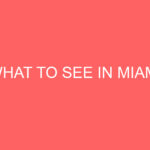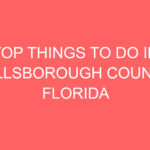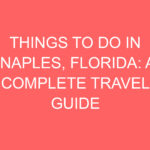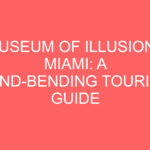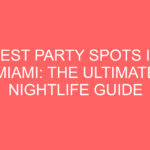Miami is often associated with sunshine, beaches, and vibrant nightlife, yet its true allure lies deeper — in its rich layers of history and heritage. Beneath the neon glow of Ocean Drive and the glass towers of Downtown, the city preserves traces of every era that shaped it — from the Tequesta tribes who first called it home, to the railway pioneers, artists, and immigrants who defined its modern identity. To walk through Miami’s historic attractions is to experience a living timeline — where architecture, culture, and memory intertwine to tell the story of transformation and resilience.
1. Cauley Square Historic Railroad Village
Step back in time at Cauley Square, a beautifully preserved railway village that captures the heart of Old Florida. Founded in 1900 by William Cauley to accommodate workers building Henry Flagler’s Florida East Coast Railway, the site thrived during Miami’s earliest growth. Though the 1926 hurricane nearly destroyed it, Cauley Square was lovingly restored, preserving its wooden cottages, brick walkways, and tranquil gardens.
Visitors can stroll through artisan boutiques, vintage tea rooms, and local art studios, all housed in 19th-century-style buildings. The scent of jasmine and fresh coffee fills the air, while birds flutter above the lush courtyards. Each building tells a story — of laborers, settlers, and dreamers who helped turn the wilderness into a thriving community.
📍 Address: 22400 Old Dixie Hwy, Goulds, Miami, FL 33170
⏰ Hours: Tue–Sat 10 am–5 pm; Sun 12 pm–5 pm
💵 Admission: Free
✨ Fun Fact: During restoration, many of the historic cottages were floated on barges to prevent flood damage — an extraordinary feat that demonstrates Miami’s early innovation and determination.
💡 Insider Tip: Visit during holiday festivals or antique fairs for an immersive experience — live music, art displays, and storytelling events bring this hidden gem to life.
2. Black Archives Historic Lyric Theater
The Lyric Theater stands as a proud monument to Miami’s African-American heritage. Built in 1913 by visionary Geder Walker, it became the cornerstone of Overtown’s cultural scene. During segregation, the Lyric was one of the few theaters welcoming Black audiences, and its stage hosted musical icons such as Ella Fitzgerald, Louis Armstrong, and Nat King Cole. The neighborhood soon earned the nickname “Little Broadway.”
After decades of decline, the theater was saved by the Black Archives Foundation and meticulously restored. Its ornate interior and red-brick façade once again shine — now as a community hub for performances, exhibitions, and cultural education.
📍 Address: 819 NW 2nd Ave, Miami, FL 33136
⏰ Hours: Tours by appointment
💵 Admission: Varies by event
🏛️ Highlight: Listed on the National Register of Historic Places, the Lyric remains Miami’s oldest surviving African-American entertainment venue and continues to inspire future generations of artists.
🎭 Did You Know? The Lyric served as both a performance hall and a rallying center during the civil rights movement, symbolizing unity and artistic empowerment in turbulent times.
💡 Visitor Tip: Stop by the theater’s adjacent gallery for rotating exhibits on Overtown’s history — from jazz legends to local heroes who shaped Miami’s cultural identity.
3. City of Miami Cemetery
Established in 1897, the City of Miami Cemetery is more than a burial ground — it’s a historical archive carved in stone. Beneath its oak-shaded avenues lie pioneers, politicians, veterans, and founders who helped establish the city we know today. Julia Tuttle, the “Mother of Miami,” rests here, her gravestone inscribed with a simple but powerful tribute to her vision.
The cemetery’s headstones reflect Miami’s diversity — from Bahamian artisans to Jewish merchants and Cuban revolutionaries. The older tombs, covered in moss and coral limestone, reveal layers of architectural beauty and symbolism. Some markers are shaped like tree trunks, symbolizing life cut short, while others feature angelic sculptures typical of the Victorian garden cemetery style.
📍 Address: 1800 NE 2nd Ave, Miami, FL 33132
⏰ Hours: Mon–Fri 8 am–5 pm; Sat–Sun 8 am–4 pm
💵 Admission: Free
🌿 Fun Fact: The cemetery’s early segregation policies once divided graves by race and religion, yet today it stands as a united memorial to Miami’s multicultural heritage.
🕯️ Pro Tip: Visit during the annual HistoryMiami Cemetery Tour for fascinating stories, reenactments, and insights into the city’s early families and forgotten legends.
4. Deering Estate
Set on the shimmering shores of Biscayne Bay, the Deering Estate is one of Miami’s most captivating cultural and ecological landmarks. Once the winter home of industrial magnate Charles Deering, the estate spans 444 acres of protected wetlands, forests, and archaeological sites dating back over 10,000 years.
The estate’s architecture fuses Mediterranean Revival luxury with environmental consciousness. The Richmond Cottage offers a glimpse into early Florida pioneer life, while the grand Stone House reflects the elegance of 1920s high society. Visitors can enjoy guided tours, concerts on the lawn, nature hikes, or kayaking excursions along mangrove-lined trails.
📍 Address: 16701 SW 72nd Ave, Miami, FL 33157
⏰ Hours: Daily 10 am–5 pm
💵 Admission: $18 adults; $10 children
🌙 Tip: Join a Moonlight Tour to explore the mansion under the stars — complete with storytelling and live music.
🎨 Did You Know? Charles Deering was a devoted art collector whose private gallery included pieces by masters such as El Greco and Goya, making the estate a hidden treasure of art history.
🪶 Insider Experience: The estate is also an environmental sanctuary, home to over 150 bird species and rare butterfly populations — a paradise for photographers and naturalists alike.
5. Vizcaya Museum and Gardens
A masterpiece of European opulence blended with Floridian flair, Vizcaya Museum and Gardens is Miami’s architectural crown jewel. Built for James Deering between 1916 and 1922, this Italian Renaissance villa sits gracefully beside Biscayne Bay, surrounded by ten acres of meticulously landscaped gardens.
Every inch of Vizcaya tells a story — from its coral stone exteriors to its frescoed ceilings, Venetian-style windows, and imported European furnishings. The gardens are a botanical wonder, featuring fountains, sculptures, and a maze-like design inspired by 17th-century Italian estates. It’s a favorite spot for film shoots, weddings, and art lovers.
📍 Address: 3251 S. Miami Ave, Miami, FL 33129
⏰ Hours: Wed–Mon 9:30 am–4:30 pm
💵 Admission: $25 adults; $10 children
🌅 Don’t Miss: The iconic stone barge anchored offshore, designed as both a breakwater and an ornamental sculpture.
📸 Photography Tip: Sunrise and sunset bring magical lighting across the gardens, creating reflections worthy of postcards — perfect for travel photography or engagement shoots.
🪞 Extra Insight: Vizcaya’s design aimed to harmonize European aesthetics with Miami’s tropical climate, using open-air galleries and breezeways that cooled the interiors naturally.
6. The Barnacle Historic State Park
Hidden in the heart of Coconut Grove, The Barnacle offers a glimpse into Miami’s seafaring soul. Built in 1891 by Ralph Middleton Munroe — a yacht designer, naturalist, and one of the Grove’s founding figures — the home resembles an inverted ship’s hull, capturing both airflow and imagination.
Surrounded by ancient oaks and native hammocks, the estate remains a tranquil retreat from the urban rush. Visitors can explore its hardwood trails, boathouse, and museum exhibits, or simply sit by the bay watching sailboats drift by. The park’s atmosphere feels timeless — a reminder of Miami’s coastal simplicity before modern development.
📍 Address: 3485 Main Highway, Miami, FL 33133
⏰ Hours: Fri–Wed 9 am–5 pm
💵 Admission: $2 per person
⛵ Highlight: The annual Regatta of the Moon, held each February, draws sailing enthusiasts from around the world to honor Munroe’s maritime spirit.
🌿 Visitor Tip: Pack a picnic and enjoy it under the banyan trees — this is one of the few waterfront parks where you can feel truly secluded.
7. Freedom Tower
The Freedom Tower rises as a beacon of liberty and resilience in the heart of Downtown Miami. Originally the headquarters for The Miami News (1925), it became the Cuban Refugee Center in the 1960s, where tens of thousands of Cuban exiles were welcomed with food, healthcare, and hope.
Architecturally, it mirrors the Giralda Tower of Seville, with a mix of Spanish Renaissance and Moorish Revival elements. Inside, the Museum of Art & Design (MOAD) showcases rotating exhibitions on Cuban history, contemporary art, and migration.
📍 Address: 600 Biscayne Blvd, Miami, FL 33132
⏰ Hours: Wed–Sun 10 am–6 pm
💵 Admission: $18 adults; $12 students
🕊️ Did You Know? The Freedom Tower is nicknamed “Miami’s Ellis Island,” serving as a portal to new lives for Cuban immigrants fleeing political turmoil.
🏙️ Pro Tip: Visit the observation balcony for stunning views of Biscayne Bay and the Downtown skyline — a perfect photo opportunity.
💬 Historical Note: The tower’s role in Cuban immigration earned it National Historic Landmark status in 2008 — a rare honor shared by only a handful of Florida sites.
8. Tower Theater
The Tower Theater is one of Miami’s oldest operating cinemas and a pillar of Little Havana’s cultural landscape. Since its opening in 1926, it has hosted generations of filmgoers — from the golden age of Hollywood to the arrival of Cuban exiles who made it their home away from home. It was among the first theaters in the nation to offer bilingual screenings.
Today, it stands as both a cinema and cultural center managed by Miami Dade College, hosting international film festivals, panel discussions, and art-house screenings. Its Spanish-style façade, vintage marquee, and vibrant ambiance preserve the essence of classic Miami.
📍 Address: 1508 SW 8th St, Miami, FL 33135
⏰ Hours: Varies by event
🎬 Fun Fact: In the 1960s, locals affectionately called it “El Cine de la Ocho,” and it played a major role in helping Cuban immigrants learn English through subtitled films.
🍿 Pro Tip: Check the event calendar for themed nights and indie premieres — it’s one of the best affordable cultural experiences in the city.
9. Miami Beach Art Deco Historic District
Few neighborhoods capture the spirit of Miami like the Art Deco Historic District. Stretching along Ocean Drive, Collins Avenue, and Washington Avenue, this area houses over 800 historic structures from the 1920s to the 1940s — the world’s largest concentration of Art Deco architecture.
Every pastel building, from the iconic Colony Hotel to The Carlyle, tells a story of glamour and resilience. The geometric shapes, chrome accents, and neon signs symbolize optimism after the Great Depression. Today, the district is a living museum, blending nostalgia with modern luxury.
📍 Location: Ocean Drive, Collins Ave, and Washington Ave (5th–23rd Streets)
💵 Admission: Free
🌴 Pro Tip: Take a guided walking tour with the Miami Design Preservation League to uncover fascinating stories behind each façade — from mobsters to movie stars.
🎨 Fun Fact: The signature color palette — seafoam green, coral pink, and canary yellow — was chosen to reflect the natural beauty of Miami’s sunsets and tropical waters.
🌆 Extra Tip: Visit after dark to see the neon lights illuminate the buildings — it’s the quintessential South Beach experience.
10. HistoryMiami Museum
HistoryMiami Museum serves as the city’s memory bank — a space where 12,000 years of human history are preserved and celebrated. Founded in 1940, the museum documents every chapter of South Florida’s evolution, from the ancient Tequesta settlements to the modern metropolis of today.
Exhibits include shipwreck artifacts, vintage trolleys, old maps, and oral histories from the region’s immigrant communities. The museum also offers guided walking and bus tours, connecting visitors to living history across neighborhoods like Little Haiti, Overtown, and Coconut Grove.
📍 Address: 101 W. Flagler St, Miami, FL 33130
⏰ Hours: Thu–Sun 12 pm–5 pm
💵 Admission: $15 adults; $8 children
🗺️ Highlight: Take part in a curator-led tour to explore Miami’s hidden past, including rare photographs and historical artifacts not found anywhere else.
📚 Insider Tip: Don’t miss the museum’s annual City Tours program — it brings Miami’s history to life through storytelling and exploration.
11. Domino Park (Máximo Gómez Park)
Located in the heart of Little Havana, Domino Park (Máximo Gómez Park) is the heartbeat of the Cuban-American community. Since the 1970s, this open-air social hub has been where elders gather to play dominoes, drink Cuban coffee, and discuss politics with passion and pride. The park’s energy is contagious, filled with laughter, rivalry, and nostalgia.
Murals of Cuban patriots surround the domino tables, while the Walk of Stars outside honors Latin legends from Gloria Estefan to Celia Cruz. It’s not merely a park — it’s a daily celebration of identity and heritage.
📍 Address: 801 SW 15th Ave, Miami, FL 33135
⏰ Hours: 9 am–6 pm daily
💵 Admission: Free
⭐ Fun Fact: Máximo Gómez, whom the park honors, was a key general in Cuba’s war for independence against Spain — a symbol of freedom and endurance echoed in Miami’s immigrant spirit.
☕ Pro Tip: Grab a cafecito from the nearby ventanita and watch locals compete — it’s one of Miami’s most authentic cultural experiences.
Final Thoughts
Miami’s historic attractions weave together a narrative of perseverance, artistry, and transformation. Each site — from the quiet cottages of Cauley Square to the glittering neon of South Beach — reveals how diverse communities built a city that embraces both past and future.
Exploring these landmarks isn’t just sightseeing; it’s storytelling. They remind visitors that Miami’s beauty isn’t just found in its beaches or skyline but in its living memory — the people, traditions, and architecture that continue to define it. Whether you’re a first-time visitor or a longtime resident, exploring Miami’s timeless heritage is an invitation to connect with the soul of the Magic City — a place where history still breathes beneath the palm trees.


